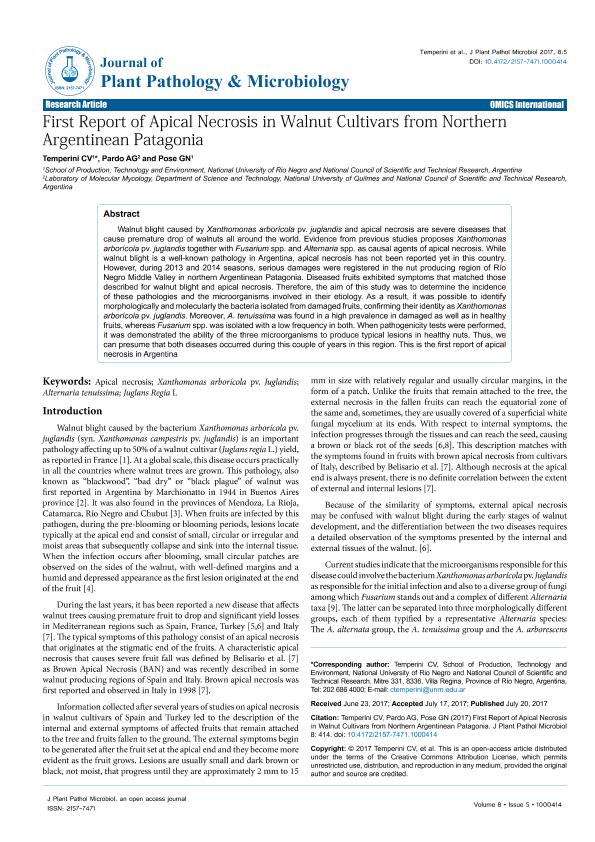Artículo
First Report of Apical Necrosis in Walnut Cultivars from Northern Argentinean Patagonia
Fecha de publicación:
07/2017
Editorial:
Longdom Publishing
Revista:
Journal of Plant Pathology and Microbiology
ISSN:
2157-7471
Idioma:
Inglés
Tipo de recurso:
Artículo publicado
Clasificación temática:
Resumen
Walnut blight caused by Xanthomonas arborícola pv. juglandis and apical necrosis are severe diseases that cause premature drop of walnuts all around the world. Evidence from previous studies proposes Xanthomonas arborícola pv. juglandis together with Fusarium spp. and Alternaria spp. as causal agents of apical necrosis. While walnut blight is a well-known pathology in Argentina, apical necrosis has not been reported yet in this country. However, during 2013 and 2014 seasons, serious damages were registered in the nut producing region of Río Negro Middle Valley in northern Argentinean Patagonia. Diseased fruits exhibited symptoms that matched those described for walnut blight and apical necrosis. Therefore, the aim of this study was to determine the incidence of these pathologies and the microorganisms involved in their etiology. As a result, it was possible to identify morphologically and molecularly the bacteria isolated from damaged fruits, confirming their identity as Xanthomonas arborícola pv. juglandis. Moreover, A. tenuissima was found in a high prevalence in damaged as well as in healthy fruits, whereas Fusarium spp. was isolated with a low frequency in both. When pathogenicity tests were performed, it was demonstrated the ability of the three microorganisms to produce typical lesions in healthy nuts. Thus, we can presume that both diseases occurred during this couple of years in this region. This is the first report of apical necrosis in Argentina
Archivos asociados
Licencia
Identificadores
Colecciones
Articulos(CCT - PATAGONIA NORTE)
Articulos de CTRO.CIENTIFICO TECNOL.CONICET - PATAGONIA NORTE
Articulos de CTRO.CIENTIFICO TECNOL.CONICET - PATAGONIA NORTE
Citación
Temperini, Carolina Virginia; Pardo, Alejandro Guillermo; Pose, Graciela Noemi; First Report of Apical Necrosis in Walnut Cultivars from Northern Argentinean Patagonia; Longdom Publishing; Journal of Plant Pathology and Microbiology; 8; 7; 7-2017; 1-6
Compartir
Altmétricas




